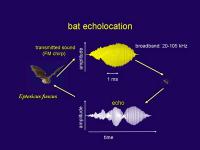-
Inspired by bats, sensor technology detects dangerous structural cracks

Researchers have developed an ultrasound sensor for detecting dangerous cracks in structures such as aircraft engines, oil, and gas pipelines, and nuclear plants. The device, known as a transducer, identifies structural defects with varying ultrasonic frequencies and overcomes the limits of other, similar devices, which are based on rigid structures and have narrow ranges. It is thought to be the first device of its kind in the world.
-
-
U.S. Navy champions unmanned systems over, on, and under the sea
The presence of unmanned systems in the maritime military domain is growing, and the U.S. Navy has decided to make several organizational, and conceptual, changes in order to deal with unmanned systems in a more holistic fashion. Rear Adm. Robert P. Girrier has been named the Navy’s first director of unmanned weapon systems, and Secretary of the Navy Ray Mabus announced in April that he would appoint a new Deputy Assistant Secretary of the Navy for Unmanned Systems, “so that all aspects of unmanned — in all domains — over, on and under the sea and coming from the sea to operate on land — will be coordinated and championed.”
-
-
Florida teens hold their own in challenging maritime robotics competitions
For the past three years, Team S.S. Minnow from Florida – consisting of Nick Serle, 15, and Abby Butka, 14 – has been competing against some of the finest technical universities in the world via the SeaPerch, RoboSub, and RoboBoat robotic competitions, all cosponsored by the Office of Naval Research (ONR). “I’ve seen Nick and Abby rise through these contests and become fierce competitors,” said Kelly Cooper, a program officer in ONR’s Sea Warfare and Weapons Department. “It is success stories like theirs that motivate us to support these competitions.”
-
-
Space elevator technology granted U.S. patent

Pembroke, Ontario-based space company Thoth Technology has been granted the United States patent for a space elevator. The space elevator is a freestanding space tower which is pneumatically pressurized and actively guided over its base. The company envisions a tower 20 km tall, which is more than twenty times the height of current tall structures. The space tower will be used for wind-energy generation, communications, and tourism.
-
-
Counter-drone technologies demonstrated at DoD’s Black Dart event
Small, unmanned aircraft systems (UASs, aka UAVs, for unmanned aerial vehicle), or drones, are easy to obtain and launch and they are hard to detect on radar, making them of particular concern to law enforcement and the Department of Defense. Earlier this month DHS circulated an intelligence assessment to police agencies across the United States warning about drones being used as weapons in an attack. DOD says that Black Dart 2015, which began 26 July and ran through 7 August, is the Department of Defense’s largest live-fly, live-fire joint counter-UAS technology demonstration. One of the innovative developers of counter-UAS technologies is SRC Inc., a not-for-profit company formerly affiliated with Syracuse University. The company showed its SR Hawk surveillance radar, which is integral to its layered approach to defending against UASs.
-
-
DHS S&T licenses innovative communication technology to commercial partners
DHS Science and Technology Directorate (S&T) last week announced that it has licensed the Radio Internet-Protocol Communications Module (RIC-M) to two commercial partners. RIC-M, used by local, state, and federal responders, is a low-cost, external, stand-alone, interface device that connects radio frequency (RF) system base stations, consoles and other RF equipment — regardless of brand — over the Internet or Private Internet Protocol (IP) network.
-
-
Three new Engineering Research Centers to advance U.S. resiliency, sustainability

The NSF awards $55.5 million for compact mobile power, off-grid water treatment, and nature-inspired soil engineering. The NSF says that innovations that improve the affordability, availability, quality, and resilience of infrastructure services will enhance the nation’s economic competitiveness and societal well-being.
-
-
Cars to harvest energy from bumps in the road

The 255 million cars on the road in the United States account for 40 percent of the country’s fuel consumption. Most of that fuel is wasted. Engineers may have a partial solution: harvesting energy from the car’s suspension. Only 10 to 16 percent of the fuel a car consumes is actually used to drive — that is, to overcome road resistance and air drag. Most of the rest is lost to heat and other inefficiencies. With clever engineering, however, that deficit can be reduced. Three major opportunities exist for recovering or generating energy while driving: the waste heat given off by the engine, the kinetic energy absorbed during braking, and the vibrational energy dampened by the shock absorbers.
-
-
Students race robot submarines in RoboSub competition
High school and college engineering students from across the globe competed for bragging rights and cash prizes at the 18th International RoboSub Competition, which wrapped up 26 July. The mission theme for this year’s contest played on the theme of the “Back to the Future,” movie trilogy. The individual autonomous underwater vehicle (AUV) had to navigate and complete an obstacle course — with tasks like “check the flux capacitor” and “travel through the time portal” — without human or computer interaction by team members.
-
-
New 3-D camera technology to uncover hidden landmines
It is estimated there are 110 million landmines buried across the world, with the potential to kill and maim innocent men, women, and children for decades to come. Yet landmine detection techniques have barely changed since the Second World War. The UN estimates that, using current technology, it would take more than 1,100 years to clear the estimated 110 million landmines situated in seventy countries. Researchers are exploring new landmine detection technologies.
-
-
Safer structures to withstand earthquakes, windstorms
A new cyberinfrastructure effort funded by a $13.7 million grant from the National Science Foundation will help engineers build safer structures that can better withstand natural hazards such as earthquakes and windstorms. Researchers aim to build a software platform, data repository, and tools that will help the United States design more resilient buildings, levees, and other public infrastructure that could protect lives, property and communities.
-
-
Bomb-proof lining contains explosion in aircraft’s luggage hold
A bomb-proof lining developed by an international team of scientists has successfully contained blasts in a series of controlled explosions in the luggage hold of a Boeing 747 and an Airbus 321. The Fly-Bag, which lines an aircraft’s luggage hold with multiple layers of novel fabrics and composites, was tested last week under increasing explosive charges on disused planes. The tests, using this technology, have demonstrated that a plane’s luggage hold may be able to contain the force of an explosion should a device concealed within a passenger’s luggage be detonated during a flight.
-
-
Accelerometers embedded in ear tags detect disease in beef cattle
A smartphone switches its orientation from portrait to landscape depending on how it’s tilted. A car’s airbags inflate when it senses collision forces. By detecting earth’s vibrations, a computer can measure the magnitude and aftershocks of an earthquake. These technologies are made possible by accelerometers — small, electromechanical devices that measure acceleration. The devices are able to detect the most sensitive of motions, from the number of steps taken during a morning walk to the number of jaw movements during a heifer’s morning meal. In fact, some dairy producers use these devices to measure feed intake, detect heat and notably, identify sick animals.
-
-
Detecting illegal, designer drugs from a single fingerprint
An innovative technology can detect the presence of a range of illegal and designer drugs from a single fingerprint, which could be a valuable new tool in bringing drug dealers and other criminals to justice. The technology, known as Matrix Assisted Laser Desorption Ionization Mass Spectrometry Imaging (MALDI-MSI), can detect the presence of cocaine, THC (the chemical present in marijuana), heroin, amphetamine and other designer drugs from a fingerprint.
-
-
RoboBoats compete for water supremacy
In a race for points, honor and cash, sixteen teams — from the United States and as far away as Indonesia, Taiwan, and South Korea — hit the water with custom-built autonomous surface vehicles (ASVs) at the eighth annual RoboBoat Competition, held 7-12 July in Virginia Beach, Virginia. The competition is an autonomous robotics contest where teams put their student-built ASVs through a series of challenges.
-
More headlines
The long view
Autonomous Vehicle Technology Vulnerable to Road Object Spoofing and Vanishing Attacks
Researchers have demonstrated the potentially hazardous vulnerabilities associated with the technology called LiDAR, or Light Detection and Ranging, many autonomous vehicles use to navigate streets, roads and highways. The researchers have shown how to use lasers to fool LiDAR into “seeing” objects that are not present and missing those that are – deficiencies that can cause unwarranted and unsafe braking or collisions.
Tantalizing Method to Study Cyberdeterrence
Tantalus is unlike most war games because it is experimental instead of experiential — the immersive game differs by overlapping scientific rigor and quantitative assessment methods with the experimental sciences, and experimental war gaming provides insightful data for real-world cyberattacks.
Prototype Self-Service Screening System Unveiled
TSA and DHS S&T unveiled a prototype checkpoint technology, the self-service screening system, at Harry Reid International Airport (LAS) in Las Vegas, NV. The aim is to provide a near self-sufficient passenger screening process while enabling passengers to directly receive on-person alarm information and allow for the passenger self-resolution of those alarms.
Falling Space Debris: How High Is the Risk I'll Get Hit?
An International Space Station battery fell back to Earth and, luckily, splashed down harmlessly in the Atlantic. Should we have worried? Space debris reenters our atmosphere every week.
Testing Cutting-Edge Counter-Drone Technology
Drones have many positive applications, bad actors can use them for nefarious purposes. Two recent field demonstrations brought government, academia, and industry together to evaluate innovative counter-unmanned aircraft systems.
Strengthening the Grid’s ‘Backbone’ with Hydropower
Argonne-led studies investigate how hydropower could help add more clean energy to the grid, how it generates value as grids add more renewable energy, and how liner technology can improve hydropower efficiency.
The Tech Apocalypse Panic is Driven by AI Boosters, Military Tacticians, and Movies
From popular films like a War Games or The Terminator to a U.S. State Department-commissioned report on the security risk of weaponized AI, there has been a tremendous amount of hand wringing and nervousness about how so-called artificial intelligence might end up destroying the world. There is one easy way to avoid a lot of this and prevent a self-inflicted doomsday: don’t give computers the capability to launch devastating weapons.
The Tech Apocalypse Panic is Driven by AI Boosters, Military Tacticians, and Movies
From popular films like a War Games or The Terminator to a U.S. State Department-commissioned report on the security risk of weaponized AI, there has been a tremendous amount of hand wringing and nervousness about how so-called artificial intelligence might end up destroying the world. There is one easy way to avoid a lot of this and prevent a self-inflicted doomsday: don’t give computers the capability to launch devastating weapons.
